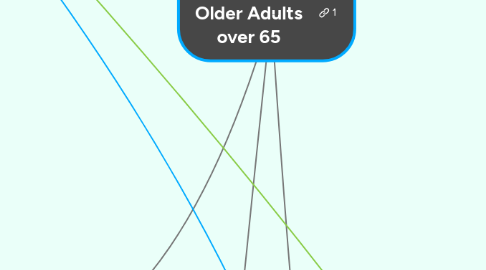
1. Support Services
1.1. Local Community Centres
1.1.1. Health and Wellbeing Programs
1.1.1.1. YMCA
1.1.1.2. Living Longer Living Stronger
1.1.2. Social events
1.1.2.1. Victorian Seniors Festival October 2019
1.1.3. Inter-generational Programs
1.1.4. Skills Based Classes
1.1.4.1. Art & Craft
1.1.4.2. Music & Dance
1.1.4.3. Gardening
1.1.4.4. Men's Shed
1.2. Buddy Programs
1.2.1. Red Cross
1.2.2. Dementia Australia
1.3. Help at Home
1.3.1. ADLs
1.3.1.1. Cooking
1.3.1.2. Cleaning
1.3.1.3. Personal Care
1.3.1.4. Shopping
1.3.1.5. Paying bills
1.4. Pet Therapy
1.4.1. The Delta Society
1.4.2. Dogs Victoria Therapy Dogs
1.4.3. Real Animals Pets and People
1.5. Transport
1.5.1. Multi Purpose Taxi Program
1.5.2. Seniors Myki
1.6. Crisis Support
1.6.1. Lifeline
1.6.2. Beyond Blue
1.6.3. Suicide Call Back Service
1.6.4. Open Arms (Veterans and Families Counselling)
1.7. Drug & Alcohol
1.7.1. Older Wiser Lifestyle (OWL) Program
1.8. Housing
1.8.1. Residential Aged Care
1.8.2. APMH nursing homes and hostels
1.9. Community Visitors (CVS)
1.10. Personal Alert Victoria (PAV)
1.11. Support for Carers Program
2. Key issues
2.1. Symptoms
2.1.1. arthritis pain
2.1.2. headaches
2.1.3. loss of energy
2.1.4. misdiagnosed
2.1.4.1. ageing
2.1.4.2. dementia
2.1.4.3. dilusion
2.2. Causes
2.2.1. Isolation & loneliness
2.2.1.1. accessibility
2.2.1.2. social circle
2.2.1.3. family ties
2.2.2. Physical ill health
2.2.2.1. disability
2.2.2.2. medications
2.2.3. Loss in old age
2.2.3.1. symbolic
2.2.3.2. real loss
3. Standards and Legislation
3.1. Standards of Care
3.1.1. 1. Dignity and choice
3.1.1.1. links to all standards
3.1.1.2. consumer centred care
3.1.1.2.1. Dignity and respect
3.1.1.3. consumer choice
3.1.1.3.1. right to make decisions that effect their life
3.1.1.3.2. decision making support
3.1.2. 2. On going assessment and planning with consumers
3.1.2.1. consumer needs
3.1.2.2. obtain care and services
3.1.2.2.1. healthcare team
3.1.3. 3. Personal care and clinical care
3.1.3.1. safety and care
3.1.3.2. optimise health and well-being
3.1.3.3. services and assistant provided to consumer with depression
3.1.4. 4. Services and supports for daily living
3.1.4.1. optimise health and well-being
3.1.4.1.1. safe and effective services
3.1.4.1.2. therapy services
3.1.5. 7. Human resources
3.1.5.1. organisation provides skilled and qualified workforce
3.1.5.1.1. safe
3.1.5.1.2. receptful
3.1.5.1.3. manage
3.1.6. 8. Organisational governance
3.1.6.1. organisations held responsible
3.1.6.1.1. safe and quality of care
3.1.6.2. governing body
3.2. Legislation
3.2.1. State and Territory mental health, guardianship and administration, during power of attorney and medical directive/advanced care planning legislation
3.2.1.1. Advanced Care Planning
3.2.1.1.1. planning for future health and personal care
3.2.2. Aged Care Charter of Rights
3.2.2.1. consumer rights
3.2.3. Aged Care Act 1997
3.2.3.1. funding
3.2.3.2. regulation
3.2.3.3. quality of care
3.2.3.4. rights of consumers
3.2.4. Mental Health Act 2014
3.2.4.1. assessment
3.2.4.2. treatment
3.2.5. Aged Care quality Standards, 2018
4. Client & Carer
4.1. risk factors to the older adult
4.1.1. denial
4.1.2. lack of support
4.2. role of carers
4.2.1. facilitators
4.2.1.1. accessability
4.2.1.2. risk prevention
4.2.2. barriers
4.2.2.1. relationship dynamics
4.2.2.2. dignity
4.2.2.3. finances
5. patient safety
5.1. Duty of Care
5.2. Early detection and prevention
5.3. Support services
5.3.1. Help at home
5.3.2. personal alert victoria
5.3.3. beyond blue
5.3.4. lifeline
6. Risk Management
6.1. Assessment
6.1.1. Physical
6.1.1.1. Integumentary
6.1.2. Mental
6.1.2.1. Family history of mental illness
6.1.2.2. Mini mental exam
6.1.2.3. Complete mental health examination
6.1.2.4. Scale to assess risk of suicide (SARS)
6.2. Prevention
6.2.1. Detecting triggers to avoid
6.2.2. Set up with helpline / allied health professionals
6.2.3. Engage clients in health promoting activities
6.3. Education
6.3.1. Early onset of symptoms
6.3.2. Family and friends
6.3.3. Clinical Risk management education
6.4. Healthcare
6.4.1. GP
6.4.2. Psychologist
6.4.3. Ocupational therapist
6.4.3.1. Protect against risks of fall
6.4.3.2. Keeping patient active & social within community
6.4.4. Community support
6.4.4.1. Support groups
6.4.4.1.1. Activity groups to stay social
6.4.5. Online
6.4.5.1. Beyond Blue
6.4.5.2. Black Dog Institute
6.4.6. At Home
6.4.6.1. Mood GYM
6.4.6.2. Mental Health Carers Australia
6.4.6.3. Helpguide.org
6.4.6.4. Suicide call back service
7. Healthcare Team
7.1. General Health
7.1.1. Nurse
7.1.1.1. Nurse Practitioner (NP)
7.1.1.1.1. Care Management
7.1.1.1.2. Education
7.1.1.1.3. Advocacy
7.1.1.2. Registered Nurse (RN)
7.1.1.3. Community Nurse (RDNS)
7.1.1.4. Enrolled Nurse (EN)
7.1.2. General Practitioner (GP)
7.1.2.1. Central Role
7.1.2.1.1. Education
7.1.2.1.2. Medication
7.1.2.2. Referrals
7.1.2.2.1. Mental Health Care Plan
7.1.2.2.2. Specialists
7.1.2.2.3. Pathology
7.1.3. Pharmicist
7.1.3.1. Medication
7.1.3.2. Education
7.1.4. Personal Care Attendant (PCA)
7.1.4.1. Personal Care
7.1.4.2. Housekeeping
7.1.4.3. Support in the community
7.2. Mental Health
7.2.1. Psychologist
7.2.1.1. Assessment
7.2.1.2. Diagnosis
7.2.1.3. Treatment
7.2.1.3.1. Psychotherapy
7.2.1.3.2. Counselling
7.2.2. Psychiatrist
7.2.2.1. Assessment
7.2.2.2. Diagnosis
7.2.2.3. Treatment
7.2.2.3.1. Psychotherapy
7.2.2.3.2. Counselling
7.2.2.3.3. Medication
7.2.3. Counsellor
7.2.3.1. Education
7.2.3.2. Communication
7.2.4. Social Worker
7.2.4.1. Assessment
7.2.4.2. Counselling
7.2.4.3. Mediation
7.2.4.4. Advocacy
7.2.4.5. Case Management
7.3. Physical Health
7.3.1. Occupational Therapist
7.3.1.1. Falls Prevention
7.3.1.2. Safety & Accessibility
7.3.1.2.1. Equipment
7.3.1.3. Function & Mobility
7.3.1.3.1. Maintenance of Independence
7.3.1.3.2. Adaptive Strategies
7.3.1.4. Education
7.3.1.4.1. Age Related Changes
7.3.2. Physiotherapist
7.3.2.1. Physical Assessment
7.3.2.2. Diagnosis
7.3.2.3. Treatment and management of:
7.3.2.3.1. Musculoskeletal injuries
7.3.2.3.2. Cardiothoracic problems
7.3.2.3.3. Neurological problems
7.3.2.4. Lifestyle Modification
7.3.2.5. Prescribe aids and appliances
7.3.2.6. Prescribe exercise for clients & carers
7.3.3. Exercise Physiologist
7.3.3.1. Physical Assessment
7.3.3.2. Clinical Exercise Interventions
7.3.3.2.1. Restore optimal physical function
7.3.3.2.2. Exercise Prescription
7.3.3.2.3. Prevent and/or manage injury
7.3.3.3. Lifestyle Modification
7.3.3.3.1. Education
7.3.3.3.2. Support
7.3.4. Dietitian
7.3.4.1. Medical Nutrition Therapy
7.3.4.1.1. Manage medical condition(s) and symptoms via diet
7.3.4.1.2. Assess health and nutritional needs
7.3.4.2. Food Service Management
7.3.4.2.1. Menu assessment and planning
7.3.4.2.2. Compliance monitoring of therapeutic diets
7.3.4.3. Community and Public Health Nutrition
7.3.4.3.1. Preventive health programs
7.3.4.3.2. Food security programs
7.3.4.3.3. Education for groups
7.3.4.3.4. Supermarket tours and cooking classes
7.3.4.3.5. Meal Preparation & Assistance
7.3.5. Allied Health Assistant
7.3.5.1. Supervised assistant role
